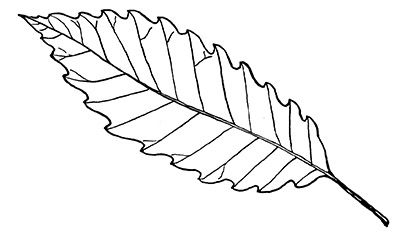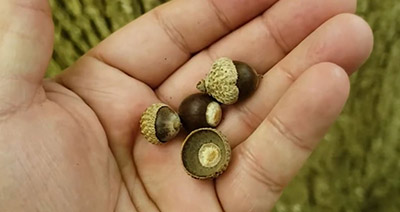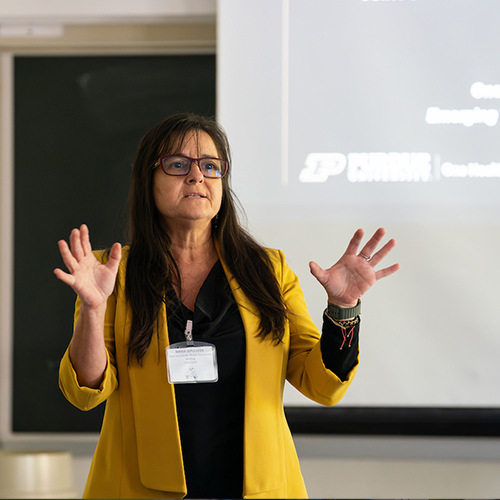Intro to Trees of Indiana: Chinkapin Oak
The classic and trusted book "Fifty Common Trees of Indiana" by T.E. Shaw was published in 1956 as a user-friendly guide to local species. Nearly 70 years later, the publication has been updated through a joint effort by the Purdue Department of Forestry and Natural Resources, Indiana 4-H, and the Indiana Department of Natural Resources, and reintroduced as "An Introduction to Trees of Indiana."
A printed copy of the full publication is available for purchase for $7 in the Purdue Extension Education Store. The field guide helps identify common Indiana woodlot trees.
Each week, the Intro to Trees of Indiana web series will offer a sneak peek at one species from the book, paired with an ID That Tree video from Purdue Extension forester Lenny Farlee to help visualize each species as it stands in the woods. Threats to species health as well as also insight into the wood provided by the species, will be provided through additional resources as well as the Hardwoods of the Central Midwest exhibit of the Purdue Arboretum, if available. 
This week, we take a look at the fifth of our oak varieties in Indiana, the Chinkapin Oak or Quercus muehlenbergii.
Also known as the Chinquapin Oak, the leaves of this species feature shallow, evenly lobed margins, but appear to have sharp-pointed teeth at the end resembling red or black oaks. This sharp point, however, is due to a gland at the end of the leaves, and there is no bristle tip as are typically found on red and black oaks. The shape of the leaves can be either broad like chestnut oak, or narrower.
Like other members of the white oak group, the bark of chinkapin oak is light gray and ashy, however it has a flaky appearance.
 The fruit of the chinkapin oak is a small acorn that is dark brown or almost black in color. It has a cap that resembles a stocking cap, covering a third or half of the acorn, that features loose knobby scales. Under the cap, the acorn has a large white spot similar to that of a buckeye.
The fruit of the chinkapin oak is a small acorn that is dark brown or almost black in color. It has a cap that resembles a stocking cap, covering a third or half of the acorn, that features loose knobby scales. Under the cap, the acorn has a large white spot similar to that of a buckeye.
Chinkapin oaks, which grow to 50 to 80 feet tall, are found in both upland and bottomland areas. The natural range of chinkapin oak is the eastern United States, with the exception of the Atlantic coast and the immediate gulf coastal plains.
The Morton Arboretum states that chinkapin oak is best grown in rich, deep soils, but that it is often found in the wild on dry, limestone outcrops in low slopes and wooded hillsides. It notes that this species is one of the best oaks for alkaline soils. As with other oaks, this chinkapin oaks should be pruned in the dormant season to avoid attracting beetles that may carry oak wilt. This species also can be affected by anthracnose, oak wilt and two-lined chestnut borers.
In general, lumber from the white oak group is among the heaviest next to hickory, weighing in at 47 pounds per cubic foot. It is very resistant to decay and is one of the best woods for steam bending. According to the Hardwood Lumber and Veneer Series, chinkapin oak can produce good quality lumber, but it is irregular in occurrence.
White oak lumber has been used for a variety of purposes including log cabins, ships, wagon wheels and furniture. It also is preferred for indoor decorative applications ranging from furniture, especially in churches, to cabinets, interior trim, millwork and hardwood flooring and veneers. It also may be used for barrel making.
Its density and durability make white oak a favorite for industrial applications such as railroad ties, mine timbers, sill plates, fence posts and boards, pallets, and blocking, as well as industrial, agricultural and truck flooring.
Other Resources:
ID That Tree: Chinkapin Oak
ID That Tree: White Oak Group
Hardwood Lumber and Veneer Series: White Oak Group
Morton Arboretum: Chinkapin Oak
Purdue Plant Doctor
Native Trees of the Midwest, The Education Store
Shrubs and Woody Vines of Indiana and the Midwest, The Education Store
Investing in Indiana Woodlands, The Education Store
Forest Improvement Handbook, The Education Store
ID That Tree, Purdue Extension-Forestry & Natural Resources (FNR) YouTube playlist
Woodland Management Moment , Purdue Extension-FNR YouTube playlist






